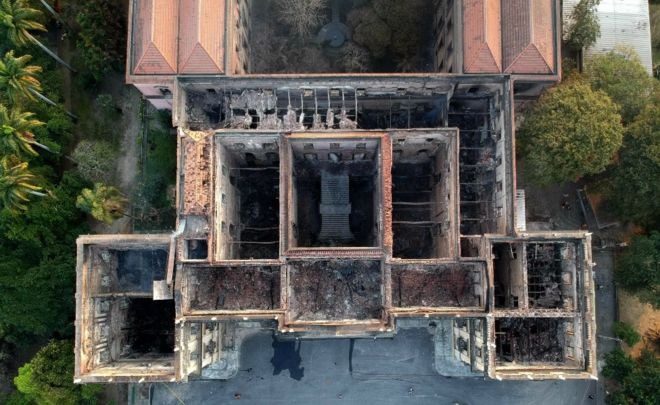Brazilian President Michel Temer says the government is seeking funding from companies and banks to help rebuild the National Museum in Rio de Janeiro after it was destroyed by fire.
Education Minister Rossieli Soares said international help was also being sought and talks with the UN’s cultural body, Unesco, were under way.
Museum officials say almost 90% of the collection has been destroyed.
Staff have blamed the fire on years of funding cuts.
The museum housed one of the largest anthropology and natural history collections in the Americas. It included the 12,000-year-old remains of a woman known as “Luzia”.
On Monday, President Temer’s office said he had held talks with officials from major Brazilian banks and businesses to examine ways to reconstruct the museum “as soon as possible”.
Addressing reporters outside the ruined building, Mr Soares said the federal government had set aside an initial 15m reais (£2.8m; $3.6m) to rebuild the structure and restore its collection.
How did the fire start?
An investigation has been launched but Culture Minister Sergio Leitao told the Estado de S.Paulo newspaper that the most likely causes were an electrical fault or a homemade paper hot-air balloon landing on the roof.
The fire started on Sunday evening, after the building – a 19th Century former royal palace – closed for the day.
It is not yet clear if the museum was insured.
The city’s fire chief, Roberto Robadey, said nearby hydrants were dry when emergency services arrived. He said crews had to get water from a nearby lake and from tanker trucks.
“Yesterday was one of the saddest days of my career,” he said.
On Monday, fire crews were sifting through the charred wreckage, occasionally emerging with an artefact or a painting they had managed to rescue.
What has the reaction been?
Riot police fired tear gas outside the park housing the museum on Monday as a small, irate crowd tried to enter.
Many demonstrators were angry at the budget cuts that they say led to the fire.
The protesters were later allowed to surround the museum’s perimeter in a symbolic “embrace.”

Luiz Fernando Dias Duarte, a deputy director at the museum, expressed “immense anger”, and accused Brazilian authorities of a “lack of attention”.
“We fought years ago, in different governments, to obtain resources to adequately preserve everything that was destroyed today,” he said.

One issue appears to be the lack of a sprinkler system.
Mr Duarte told Globo TV that a $5.3m (£4.1m) modernisation plan agreed in June would have included modern fire prevention equipment, but only after October’s elections.
Roberto Leher, rector of the Rio de Janeiro federal university which administers the museum, said the community was “very mobilised, and very indignant”.
“We all knew the building was vulnerable,” he said.
What did the museum contain?
The flames tore through hundreds of rooms containing some 20 million artefacts. They ranged from fossils and the reconstructed skeleton of a dinosaur to Roman frescoes and pre-Columbian Brazilian objects.
The jewel in the crown for many visitors was “Luzia” – the oldest human remains ever discovered in Latin America.
“Luzia is a priceless loss for everyone interested in civilisation,” museum director Paulo Knauss told AFP news agency

Using her skull, experts had produced a digital image of her face, which was used as the basis for a sculpture that was also gutted by the fire.
Another popular exhibit was the Bendegó meteorite, weighing more than five tonnes and discovered in Minas Gerais region in the 18th Century.
Deputy director Cristiana Serejo said it had survived along with part of the zoological collection, the library and some ceramics.














